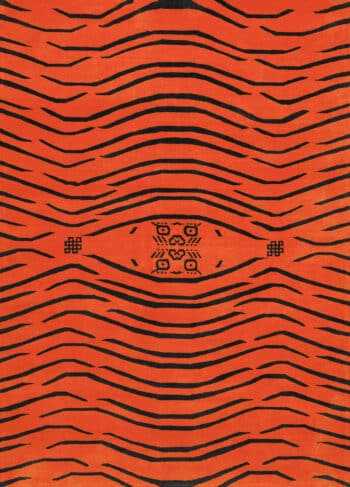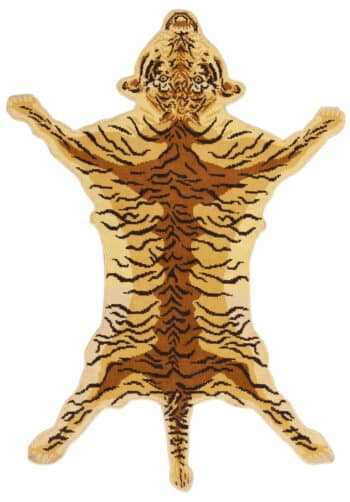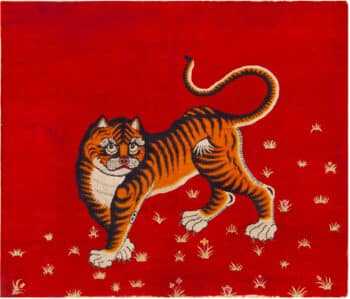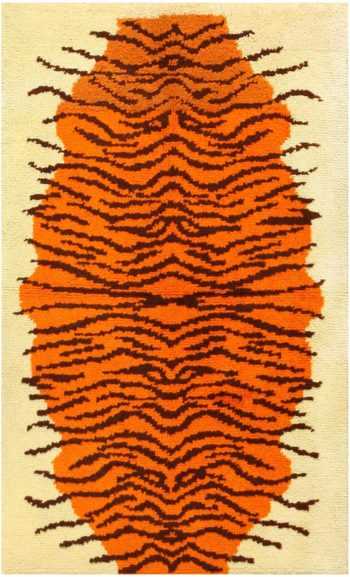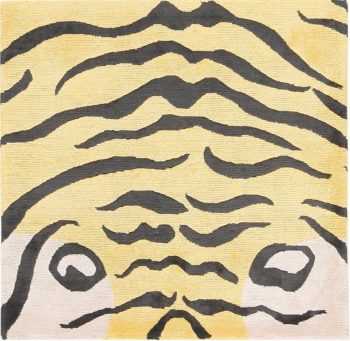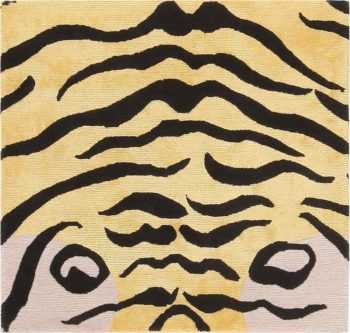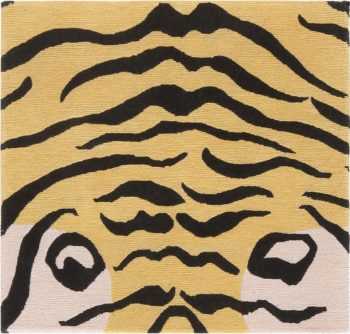Tiger Rugs
View beautiful tiger rugs from our collection
Modern Tiger Runner Rug 61125
$2,850.00Size: 2 ft 10 in x 10 ft 1 in (0.86 m x 3.07 m)Red And Black Color Artistic Modern Tiger Design Area Rug 61124
$3,650.00Size: 5 ft 1 in x 7 ft 2 in (1.55 m x 2.18 m)Vintage Tiger Animal Pelt Design Rug 72896
$3,600.00Size: 3 ft 10 in x 6 ft 2 in (1.17 m x 1.88 m)Antique Bold Colors Chinese Tiger Rug 72845
$9,600.00Size: 3 ft 1 in x 6 ft (0.94 m x 1.83 m)Red Background Antique Chinese Tiger Rug 72846
$7,650.00Size: 6 ft 4 in x 5 ft 4 in (1.93 m x 1.63 m)Vintage Tiger Pelt Design Swedish Rya Rug 48037
$3,200.00Size: 3 ft 2 in x 4 ft 10 in (0.97 m x 1.47 m)Small All Silk Modern Tiger Custom Area Rug Sample 60107
Size: 2 ft x 2 ft (0.61 m x 0.61 m)Small Wool and Silk Modern Custom Tiger Rug Sample 60106
Size: 2 ft x 2 ft (0.61 m x 0.61 m)Small All Wool Modern Tiger Custom Rug Sample 60105
Size: 2 ft x 2 ft (0.61 m x 0.61 m)
Tiger Rugs and The History of the Tiger Symbol
All Antique Rug Symbols | Search All Antique Rugs Online
This history of the tiger design
The tiger has always been a significant part of Oriental culture. Throughout history, the tiger has symbolized strength and power. It has also been admired for its beauty and respected for the danger it poses to humans. Tigers can be found in countries such as Bangladesh, Vietnam, Cambodia, India, China, etc. This is why they are so heavily depicted in the historical cultures of these regions.
What is the meaning behind the tiger deign in area rugs?
Tiger design in rugs, often referred to as tiger rugs or tiger stripe rugs, typically feature a pattern that resembles the stripes of a tiger’s fur. These designs are commonly found in traditional and antique rugs from various regions, particularly in Central Asia, including countries like China, Tibet, and Mongolia.
The tiger design holds symbolic significance in many cultures.
Here are a few possible interpretations associated with tiger motifs in rugs:
- Power and Strength: Tigers are often seen as powerful and majestic creatures, representing strength, courage, and dominance. The tiger design in rugs can evoke these qualities and serve as a symbol of vitality and potency.
- Protection and Warding Off Evil: In some cultures, tigers are believed to possess protective qualities and are considered guardians against evil spirits and negative influences. The presence of tiger motifs in rugs may be intended to provide protection and ward off malevolent forces.
- Royalty and Nobility: Tigers have been associated with royalty and nobility in various societies. The design may be used to convey a sense of regality and opulence, reflecting the high status of those who owned or used such rugs.
- Nature and Wilderness: Tigers are indigenous to certain regions and are associated with the untamed wilderness and natural world. The tiger design in rugs can represent a connection to nature, wildlife, and the wild aspects of life.
It’s important to note that the specific meaning behind tiger designs in area rugs can vary across different cultures, regions, and historical periods. Additionally, interpretations may differ based on individual perspectives and contexts.
The Chinese tiger design
In Chinese culture, the tiger is considered the ruler of the animal kingdom. It has inspired ancient Chinese cultures to create many different art forms throughout the years. The tiger is often depicted protecting people from danger. Many early art forms depicting tigers have been found including art created during the Zhou Dynasty (1046-256 B.C.).

Antique Tiger Rugs
Tigers were also very popular in art during the Han Dynasty (206 B.C- A.D. 220). During these periods, the tiger was often depicted alongside dragons. This is because they were seen as opposites that balanced each other due to the fact that dragons are imaginary while tigers are not.
What is the origin of the Tibetan tiger rug?
The origin of Tibetan tiger rugs can be traced back to the Tibetan plateau, a region known for its rich cultural heritage and unique artistic traditions. Tibetan tiger rugs are considered a significant part of Tibetan culture and have a long history.
These rugs were traditionally handwoven by Tibetan weavers using techniques passed down through generations. They were crafted using locally available materials such as wool and sometimes silk, which were dyed in vibrant colors. The intricate patterns and designs of tiger stripes were carefully woven into the rugs, often with great attention to detail.
Tibetan tiger rugs were not only used as decorative floor coverings but also held cultural and symbolic significance. They were often used in monasteries, temples, and homes, serving as religious and ceremonial objects, meditation aids, and symbols of protection.
The motifs and designs of Tibetan tiger rugs were influenced by both religious and natural elements. Tigers hold a significant place in Tibetan Buddhism, representing power, strength, and protection. The rugs incorporated tiger motifs as a way to invoke these qualities and create a sacred and powerful environment.
Over time, Tibetan tiger rugs gained popularity beyond Tibet and became sought-after collectibles and art pieces in the Western world. Their unique craftsmanship, vibrant colors, and cultural significance continue to make them highly valued and cherished rugs today.
Tiger design nuances based on origin
The way that tigers are stylized in art depends on the place the art originated. For example, tiger designs in paintings originating in China feature realistic stripes with detailed strands of hair. Whereas the tiger design art originating in Korea will generally feature simple black ink lines for stripes. Since Tigers did not inhabit Japan, the Japanese art depicting tigers tend to be less realistic and painted from the imagination or based on imagery that was provided from books.
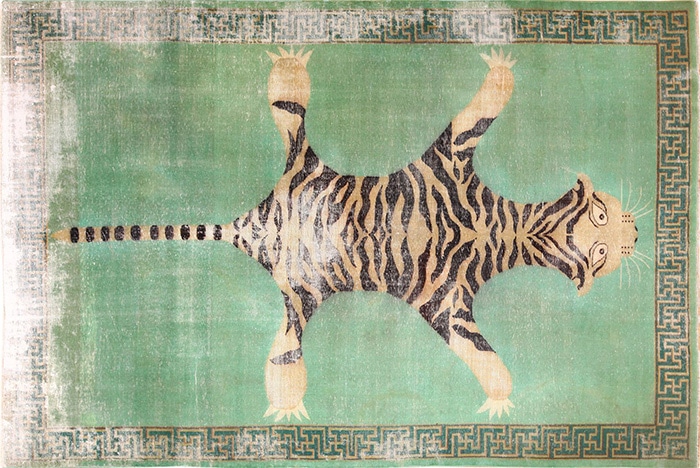
Antique Shabby Chic Tiger Design Indian Rug
Tiger designs in other cultures
The tiger also has cultural significance in many other regions, including India. In India, the tiger is considered the national animal. It represents similar qualities as in Asian culture, such as wit, endurance, and power. The tiger population in India was dwindling so, it was important that they were declared the national animal in order to protect the species.
Why are tigers so intrenched in Asian history and folklore
A thousand years ago, tigers were able to roam throughout Asia freely. People came across them quite frequently. This is part of the reason they became so ingrained in Asian history and folklore. However, tigers have also played an important role in Western culture and throughout the world. They have been featured in various films, books, and stories.

Antique Tribal Tiger Design Khotan Carpet
Does the tiger rug deign have any religious significance?
Yes, the tiger rug design does hold religious significance, particularly in Tibetan Buddhism. In Tibetan Buddhist iconography, the tiger is considered a powerful and protective animal, often associated with the bodhisattva (enlightened being) Manjushri.
Manjushri is revered as the embodiment of wisdom and is depicted in some iconographic representations as riding or accompanied by a tiger. Tigers are believed to symbolize the subjugation of ignorance and the triumph of wisdom.
In Tibetan Buddhist temples and monasteries, tiger rugs are sometimes used as seat covers or meditation mats for high-ranking lamas or esteemed teachers. Sitting on a tiger rug is believed to enhance one’s meditation practice and facilitate a connection with the qualities represented by the tiger, such as strength, fearlessness, and spiritual protection.
Furthermore, tiger design area rugs can also be found in Tibetan Buddhist rituals and ceremonies. They may be spread on the ground during religious ceremonies as a sacred space for practitioners and as a symbol of the powerful and protective presence of the tiger.
It’s important to note that while the tiger rug design has religious connotations in Tibetan Buddhism, not all tiger rugs are necessarily associated with religious practices. In some cases, tiger rugs are simply decorative items that showcase the artistry and cultural heritage of the Tibetan people.
The significance of the tiger
The tiger has always been symbolized in a manner that depicts respect. Also, many historical coats of arms throughout the world include a tiger symbol due to its strength and loyalty. They were included in the coats of arms because these were the characteristics that these groups wished to uphold. The tiger design / symbol has a lot of significant history but is still used in present day in many logos, symbols, and mascots.
Naturally, the tiger design is depicted in many Asian rugs. These antique tiger rugs, have, over the years, become some of the more collectible rugs.


